Want to get started with indoor rowing at home, not sure where to begin? We've got the essential guide for you.
It can be daunting when opening up Google and typing ‘best home workout’. The sheer quantity of information that comes hurtling back at you, from various sources, experts and locations, means that picking out the important stuff can be a tricky and time-consuming task. If you’re considering purchasing an indoor rowing machine for home use, we want this article to make that process as straightforward as possible, from selecting a rowing machine, to purchase, to setting up at home and of course to getting started on your first workouts.
At asensei we interact with thousands of users from our indoor rowing community, numerous erg manufacturers and suppliers and have an established history in creating training programs for people of varying ability and interest, all of which means we have a pretty good sense of what to buy, why to buy it and what to do with it when it arrives.
Table of Contents
- Why is Indoor Rowing a great home workout choice?
- How to select the best indoor rowing machine for your home
- How to store my indoor rowing machine
- Where to set up my indoor rowing gym
- How to set up my indoor rowing gym
- What training program should I use with my indoor rowing machine?
- Conclusion
- DOWNLOAD ASENSEI FOR FREE
Why is Indoor Rowing a great home workout choice?
There's a number of macro factors that are driving people to workout at home. With the COVID-19 pandemic many have decided that the gym is too high a health risk where there are dozens of others working out, despite the precautions that are being taken. Many others are now working from home rather than being office based, meaning that the home is the most convenient and time efficient place to workout. In addition, in a world of rising fuel prices and generally high inflation it may make sense financially to invest in a couple of targeted pieces of equipment of your own rather than pay for a relatively expensive gym membership. And some people are now starting to ditch the expense of a personal trainer in favor of relatively inexpensive digital-based training and coaching solutions, such as asensei or other online services.
When choosing home exercise options, indoor rowing should be near the top of the list. It is commonly referred to as one of the most complete workouts regardless of time or ability. A typical rowing stroke is a full-body workout, demanding action from 86% of your muscles across your legs, arm, core and back. Not only does indoor rowing condition all your key muscle groups and enable weight loss in half the time that a run or cycle would, it is high-intensity without impacting joints – it works your lungs and does not usually lead to longer-term damage to your knees, ankles and hips.
So how do you go about choosing and buying your own indoor rowing machine for home use?
How to select the best indoor rowing machine for your home
So – you’ve decided to go with the erg (the colloquial term for the indoor rowing machine) as your partner of choice for home workouts. This is where the going can get tough. As with all exercise machines, there are several notable choices to select from so when choosing your machine, you’ll need to consider how much you’re willing to spend, the space you have available and what your aims are for working out from home.
Concept2
The incumbent and strongest brand name in the space – this is the machine that sits two or three abreast in most gyms all over the world. It is also the machine of choice for competitive rowers – Concept2 are the official adjudicators of world indoor rowing records and their machines are used for the world and regional championships. Unlike the other featured ergs in this section, the Concept 2 is an air resistance machine which means you can manually adjust the resistance depending on your preference.
Compatible with asensei, Concept2 have created the industry standard in rowing machines without any frills so that you’re able to add in the coaching and technology you want. The machine comes with a performance monitor with Bluetooth capability included by default and Concept 2's commitment to an open app ecosystem means you can connect to a wide range of apps, including asensei which will guide you through various workouts and drills. The machine folds up (more on this below), can be easily stored and frankly will last you for years, probably a lifetime, even with frequent use.
Due to pent-up demand over COVID-19, supply for the RowErg machine has been a little erratic but this has now stabilised and the standard price remains around $900 direct from concept2.com (although it may vary from territory to territory). The durability of these machines and the commitment of Concept 2 to spare parts for even their oldest machines, means that there is a strong second-hand market with machines holding their value over time - taking much of the risk out of the purchase.
WaterRower
As reviewed by T3 back in March 2020, the WaterRower is one of the most aesthetically pleasing and effective indoor rowing machines on the market. If you’re looking for a realistic simulation of how it feels to row on the water (with the relaxing sound-effects to match) then the WaterRower, with its small water-filled tub and attractive wooden frame, might be the choice for you.
Immortalised by its cameo in Netflix series ‘House of Cards’, the WaterRower is a firm fan favourite amongst at-home indoor rowers, plus it’s also widely used in certain gym chains with the best known being Orange Theory Fitness and Equinox. The machine is not widely adopted in the competitive rowing world but has it's own community of die-hards that enjoy the feel and appearance of the machine. The fact that you’re technically rowing through water means that there is no need to manually adjust resistance – the harder you pull, the more resistance is generated. The machine is available in a range of hardwoods and the general appearance means that although it can be stored vertically, it would not be an eyesore on the floor in your home.
The WaterRower comes in various models with prices ranging from $895 to $2500. They’re available for purchase from local websites and dealers globally. To use with a training app such as asensei, you will need the Bluetooth commodule as an add-on to the standard S4 monitor. There is rumored to be an S5 monitor arriving on the market that comes with Bluetooth integrated so watch out for that. There are a growing number of WaterRower compatible apps available to enhance your WaterRower experience.
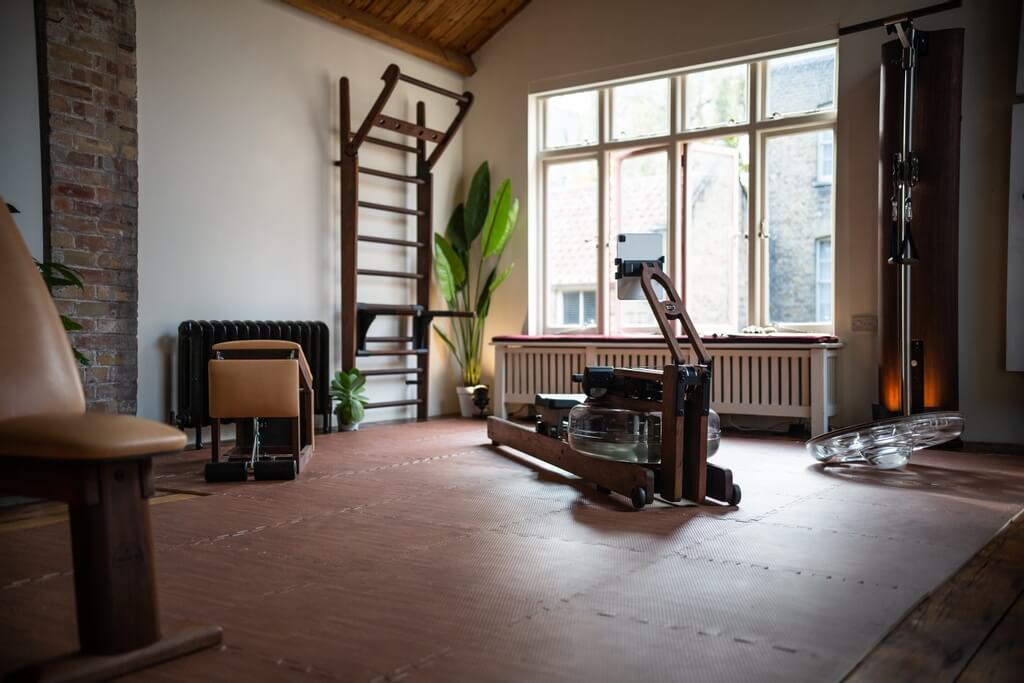
A WaterRower/NOHrD home gym setup (image (c) WaterRower).
FluidRower
Another machine that adopts the water resistance model, the FluidRower features a belt drive rather than a chain and comes in a variety of styles, aluminum, steel and wooden framed, meaning you have a chance to find something that suits your needs or matches your home location.
We’ve already referenced the obvious benefits of a water resistance workout (the natural feeling and infinite variability of the resistance) but the direct drive system in play with the FluidRower means that there is no loss of resistance at the start of the stroke. The machines are sturdy (taking weights of up to 150kg) and are perfect for rowers of all levels. The performance monitor comes highly recommended and many of the models come equipped with Bluetooth for connection to 3rd party apps. Once again, storage is not a problem as the machine can be stored vertically. Don’t be confused by this machine’s surface similarities with the WaterRower – they’re very different beasts and although both operate on a water-resistance model, the FluidRower's patented twin-tank system allows you to manually adjust your resistance from featherlight to Olympic challenge!
Prices vary, depending upon the model chosen, but you can pick a standard model up for just over $1000 with the pro models which are more suitable for commercial/gym use being significantly more expensive as you would expect. FluidRower use local distributors for sales so to purchase you would get in touch with the FluidRower supplier in your country.
Other Notable Rowing Machine Mentions
It will come as no surprise that the world of indoor rowing at home has exploded during the COVID-19 pandemic. As gyms worldwide closed their doors to fitness enthusiasts, people had to get creative – and competitive – with their home workout choices. Out of that chaos, a number of other indoor rowing machine players emerged, including Hydrow (endorsed by Kevin Hart and recently touted as having a $1bn valuation), Echelon (who made their name with indoor exercise bikes) Ergatta (who offer a custom WaterRower) and RP3 Rowing (who are arguably the competitive rowing world’s bridesmaid to Concept2). There have even been persistent rumours that Peloton, the at-home fitness giant who saw their treadmills and bikes explode into mainstream fitness consciousness during COVID-19, are bringing out their own indoor rowing machine. All these machines have varying benefits and drawbacks but generally tend to be expensive and require a regular monthly subscription to access all features (the exception being the RP3). Significantly they also tend to be much more closed ecosystems - lacking bluetooth connections to external phones or tablets and they don't offer compatibility with the world-class connected coaching experience of apps like asensei.
How to store my indoor rowing machine
According to a recently conducted British Rowing survey, one of the biggest concerns for people when purchasing a rowing machine for home use is where to store it. Not surprising given the machines are pretty big, can be heavy and at first glance unwieldy. Don’t panic though – there are a range of solutions that are adaptable to most households and the machines come with nuances and tricks that help them fit into your home.
Storing your Concept 2 Rowing Machine
Uniquely, the Concept2 RowErg rowing machine can be separated into two distinct parts (flywheel and slide) and then tucked away - in a cupboard for example. When disassembled the individual parts are considerably lighter and easier to move around your home and this can also make storage in places like cupboards significantly easier. The footprint of the standard model D RowErg is 85x65cm when stored vertically, and when separated into two parts it is just 136cm high. This feature is also particularly effective if you ever want to take it with you to an event or another location – the two-part construction enables you to relatively easily transport it from place to place even if you don’t drive a truck.
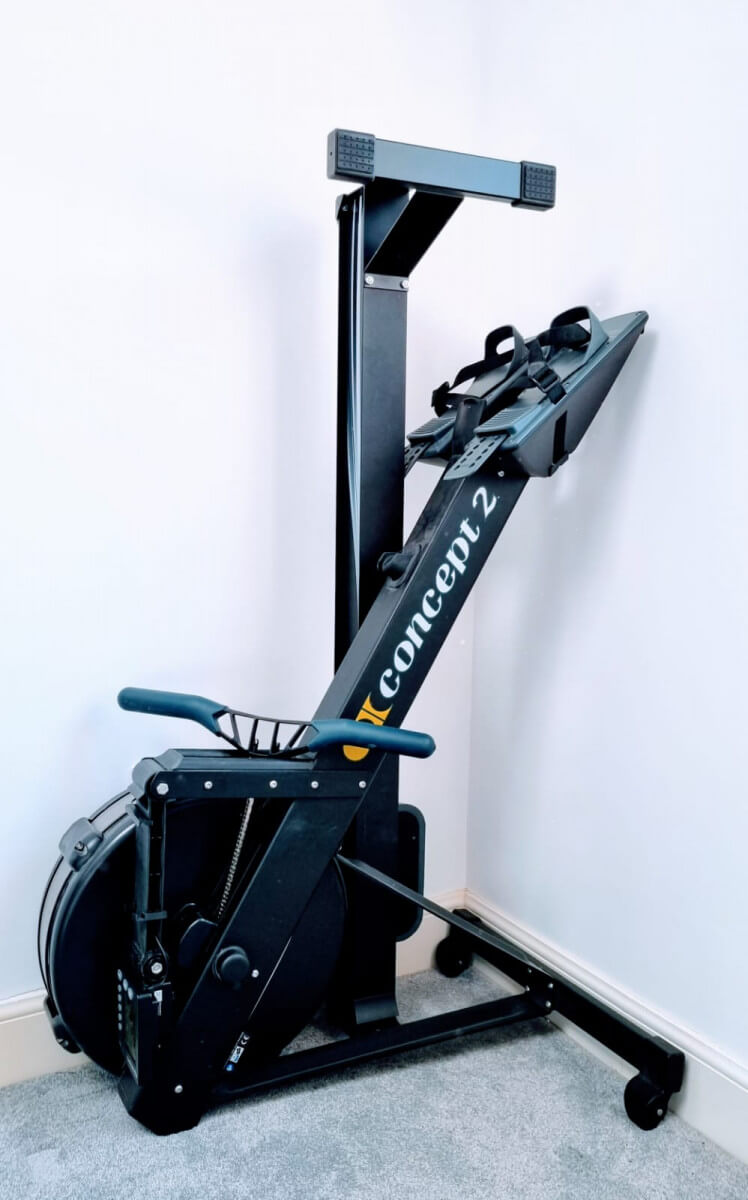
Concept 2 RowErg rowing machine stored in two pieces
The other useful feature for transportation and storage of your Concept 2 Rowerg is built-in caster wheels on the front foot, allowing you to move the machine without lifting the entire 31kg weight off of the ground. This weight incidentally compares very favorably with water based rowing machines when the tanks are filled. The quick-to-operate framelock mechanism securely connects the front end and the monorail together and ensures the machine can be rolled into place safely and easily in one piece or two.
Concept2 do not advise storing your machine vertically for reasons including danger posed by the machine falling or frame damage from resetting horizontally. There's more than one school of thought on this though and some people (and gyms) do store their machines in this way without issues. It should be noted that the Concept 2 Rowerg machine is about 244cm high when stored this way, so it can be awkward to manoeuvre into a cupboard in this configuration unless the entry is higher than most standard doorways. If you don’t like the risk of standing the machine upright unsupported then there is the option to purchase a storage rack like this wall mounted one from from Rogue Fitness (pictured below) which is inexpensive and unobtrusive - just make sure you mount it securely to the wall!

Rogue rowing machine wall hanger bracket - (C) Rogue Fitness
Storing your WaterRower or FluidRower
The WaterRower and FluidRower rowing machines are less utilitarian than the Concept 2 in appearance and the hardwood models that come in a range of shades can be more attractive to look at on a day-to-day basis if left out in the open between workouts (particularly if you have hardwood floors).
Both brands come with caster wheels on the front of the machine, which is helpful when moving the machine since the weight with tanks full can be 45kg or more. Both brands are also designed to be stored vertically, such as against a wall which helps free up precious floorspace in your chosen location. The range of models for both brands also means that there's an opportunity to coordinate the appearance to match your living spaces. We will go on to discuss the best spots in your home for workout transformation but the aesthetics mean both the WaterRower and FluidRower are more suitable for many living areas (we’d recommend choosing an area and then sticking with it - trying to shift the machines up and down stairs is not a task for the faint of heart).
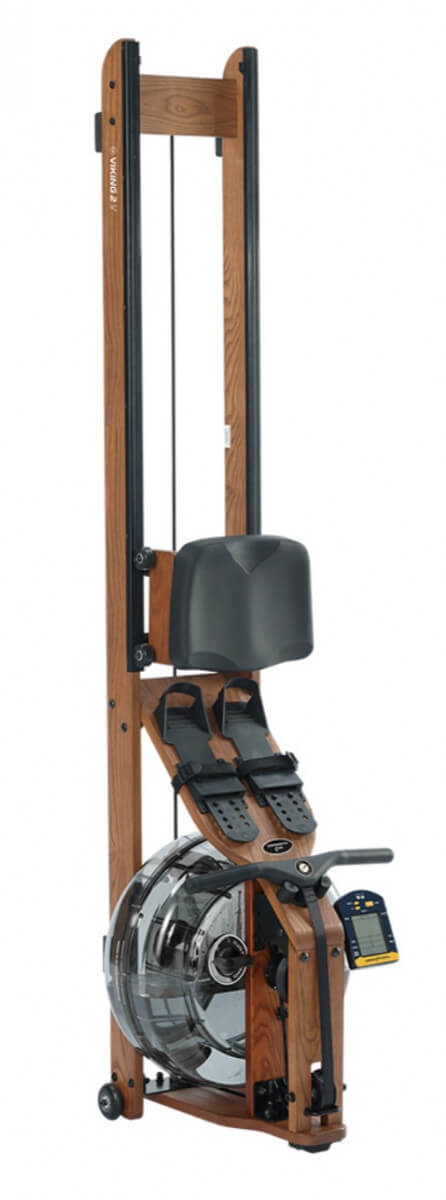
The FluidRower Viking 2 V shown above is 52x54x213cm when stored vertically, making it extremely compact and it weighs around 38kg with water in the tank.
The wooden-framed WaterRower dimensions are a little more compact than the Concept 2, being 56cm wide by 53cm high by 209cm long (or tall if standing on end) and it weighs 30kg without the water and 47kg with water in the tank. There's a detailed comparison of different WaterRower models available on their website.
WaterRower go a step further than most and offer a great design consultation service to help you get your dream home gym setup. Parent company NOHrD offer a wide range of matching gym accessories from weights, to benches racks and wall-bars through to bikes and treadmills. Typically the cost of the consultation will be deducted from your purchase making this an affordable way to get expert input to your home rowing gym setup.
Where to set up my indoor rowing gym
Now, we come to the exciting part. You’ve bought your machine, it’s arrived and you’re about ready to designate an area of your home as the fitness factory – but where and how? First, let’s go through the rooms in your house and discuss how they may (or may not) be suited to a home gym.
Garage
A natural choice, given the fact it is often annexed from the living areas and is usually full of miscellaneous equipment and items. There is usually room for an erg and space to build additional kit around it. Additionally, the noise of the machine and your exhalation won’t wake/keep up family members if you’re choosing to work out early in the morning or late at night. Some people choose to take it a step further and convert their garage into a home gym, complete with dumbbells, bikes, squat rack etc. If you’re simply looking to jump on an erg and get some mileage under your belt, this really won’t be necessary. Another useful advantage of a garage is easy access to the outdoors - whether that's opening up the garage door to give better ventilation, or dragging the machine out into the driveway or garden for a change of scene!
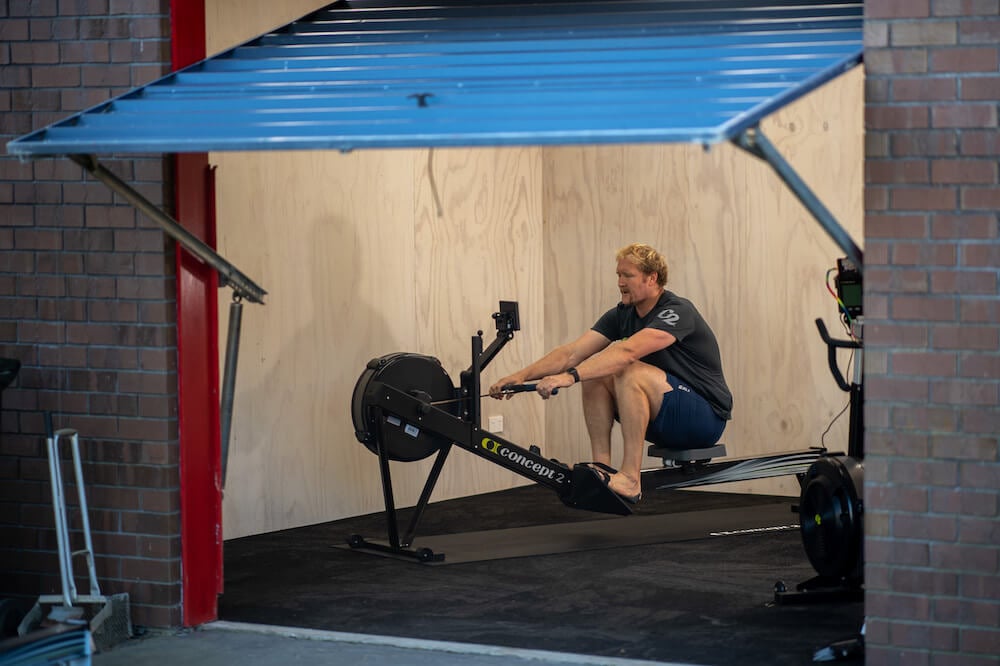
Olympic Champion Eric Murray training in a garage
Spare Room/Office
A good option if you have a room in the house that isn’t designated as something specific. A lot of people repurposed these sorts of spaces as offices over the pandemic but there is no reason why you can’t have an indoor rowing machine, particularly if it folds up and/or can be stored vertically.
The indoor rowing machine is usually quite narrow but long (typically over 2 metres) so you’ll need to make sure there is sufficient space. For their RowErg, Concept 2 recommend you have a space that is nine feet (274cm) by four feet (123cm) to give yourself room to row - although that's pretty crude and you may well get away with a smaller space depending upon your height and limb length. The front of the machine around the flywheel needs considerably less width than at the finish end of the rowing stroke, although you should avoid placing the flywheel too close to obstacles to allow good airflow. And unless you are exceptionally large the width and length requirements suggested are likely to be quite pessimistic. The author for example is around 5'10" tall and reckons that 105-110cm wide would be sufficient for his rowing stroke even with elbows fully extended at the finish. If in doubt check it out yourself though.
Living Room
Probably a less popular choice with the rest of your family/housemates (a common refrain is ‘and where am I supposed to do my living now?!’) but it’s usually one of the most spacious areas in the house and, ironically enough, isn’t always very busy. People tend to congregate in kitchens, not living rooms, and as such, you might be able to carve out time to power through a few thousand metres before being unceremoniously interrupted by somebody keen to catch up on the latest Netflix series. Another advantage of a living room is that it's often already kitted out with good audio/visual equipment to help you while away the time while working out!
Bedroom
Ideally, you’d set up the machine in an unoccupied spare bedroom but if that isn’t possible, then people have placed ergs in their own bedroom. Naturally, unless you have significant square footage to play with, your machine will have to be neatly folded/tucked somewhere unobtrusive when it is not being used. If you live alone, it may be the perfect scenario.
Outdoors
We don’t recommend storing your machine outdoors, but paradoxically it can be enjoyable to drag the erg out to a balcony, terrace, lawn or driveway and row with a different perspective. The freedom that the wheels on the machine give you are that you can move it to a conveniently shaded/sunny spot depending on your preference. It definitely isn’t advisable in wet weather and watch for extreme heat too but Indoor Rowing Outdoors can be a lot of fun!
How to set up my indoor rowing gym
If you’ve chosen an area that works, you’ll now need to consider what else you need to optimize your experience. Here are a few key things to consider:
Mats and Towels
If you think about the force required to turn the flywheel of an erg, you might realise that driving up and down the slide is likely to shift the machine underneath you. A lot of indoor rowers choose to place their erg on a mat, to minimise this movement and to negate any friction burn on the natural terrain, be that that wood, carpet or tiles.
In addition, it’s worth thinking about sweat. Indoor rowing at home is a pretty strenuous activity so keep towels close by to mop yourself up and the area around you. If you do not have a mat, it is probably worth putting some towels down at the front and back of the machine to ensure most of the perspiration is caught.
Visuals
If you’re lucky, you might be able to put your indoor rowing machine in the same room as a TV giving you loads of options to help pass the time. For some people that means working out while binging on Netflix. If you have an Apple TV, that also means you can screen-mirror your app onto the TV and enjoy a bigger screen experience so you can see your program or your asensei stats and coaches on a larger scale; however depending upon your network speed Apple TV can be a bit laggy and slow and you probably want your feedback to be as realtime as possible. To avoid the lag that can occur with screen casting you might want to use a lightning to HDMI connector directly with a long cable.
As mentioned before, asensei is compatible with most iOS devices and can simply be used on an iPhone or iPad (add in Bluetooth speakers for improved audio quality). You’ll want to make sure that your device is mounted in a location that suits your setup too, and we’ve got some great guidance for how to mount your iOS device here.
Music and Audio
How you setup your rowing audio at home will depend on many things - your living companions, your neighbors and of course your own preferences, some like it loud! You might look to invest in in-ear headphones (like Apple EarPods) if you don’t want to blast out music or your training program from a loudspeaker.
If music is one of the most important parts of your workout - and we know it is for many - then you’ll love the asensei rowing app’s curated playlists from partner feed.fm and failing that there is the flexibility to instead use Apple Music or any other audio player such as Spotify or Pandora on your Apple device.
Environment
We’d always recommend that the room you’re in has good ventilation. Indoor rowing at home, especially in the summer, demands a lot from your body and a supply of cool fresh air is critical to ensure you remain healthy and focused. If you’re outside, that should be easy. If you’re indoors, consider opting for rooms with windows that open and/or consider a small air-conditioning unit. Lighting probably matters a little less, given that iPhones/iPads and erg performance monitors are usually backlit. However, it’s still good to be in a well-lit room to avoid sensory deprivation or any trip hazards.
Further inspiration for your home rowing gym
If you are looking for more practical inspiration for your home rowing gym then it may be worth checking out the related article Inspiration for your home rowing gym setup which gives examples and photos of real home gym setups, showing how people work around the constraints of their homes to create an environment that allows them to workout at home.
What training program should I use with my indoor rowing machine?
There are a range of options for at-home training, with various pros and cons. Some people might go and search for youtube videos, which can be a useful tool, but leave you to figure out what to do and when to do it. Others may find a basic training program online, these are usually single page summaries and leave you to do the work in programming rowing machines, figuring out the pace, recording results, learning technique etc. And others may go looking for more comprehensive solutions where you can be guided through programs by a coach or by a digital solution to give you structure, accountability and progression and allows you to join an online community where your peers and coaches can give advice and support.
For most of us we want a solution that is as little hassle as possible, that allows you to setup quickly, not spend ages figuring out what workout to do today and of course something that keeps you accountable - so that you will continue to push yourself appropriately.
If you’re new to Indoor rowing at home, we would recommend signing up for a detailed program, this could be with an actual coach, online or an app-based solution. Programs, with in-built schedules and guidance, add accountability and structure to your workouts and keep you goal orientated. Plus, you’ll usually be learning from people who have significant experience in either achieving their own personal indoor rowing goals or enabling others to do so. There is a lot of information available online but it can be confusing to try and figure out which advice to follow and it can be time consuming making sense of it all, especially for a beginner.
We’re obviously a little biased here at asensei. We believe we’ve developed one of the most complete and user-friendly indoor rowing training systems on the market, with training programs featuring former Olympic champions and erg specialists who know what it takes to meet whatever goal you’re looking to achieve. You might want to lose weight, or build muscle, or lower your 2000m time, leverage the erg for cross-training alongside your existing exercise regime or you might just be looking for great workouts. We’ve designed bespoke programs that will take you down the path to perfect practice with maximum simplicity, minimum friction (no more programming the monitor, transferring data manually or figuring out target split times) and without exposing you to unnecessary risk of injury. asensei keeps track of all your stats and sets you personalized target times, keeping you accountable as you workout. As stated, asensei is compatible with many of the leading players in the Indoor rowing at home machine market.
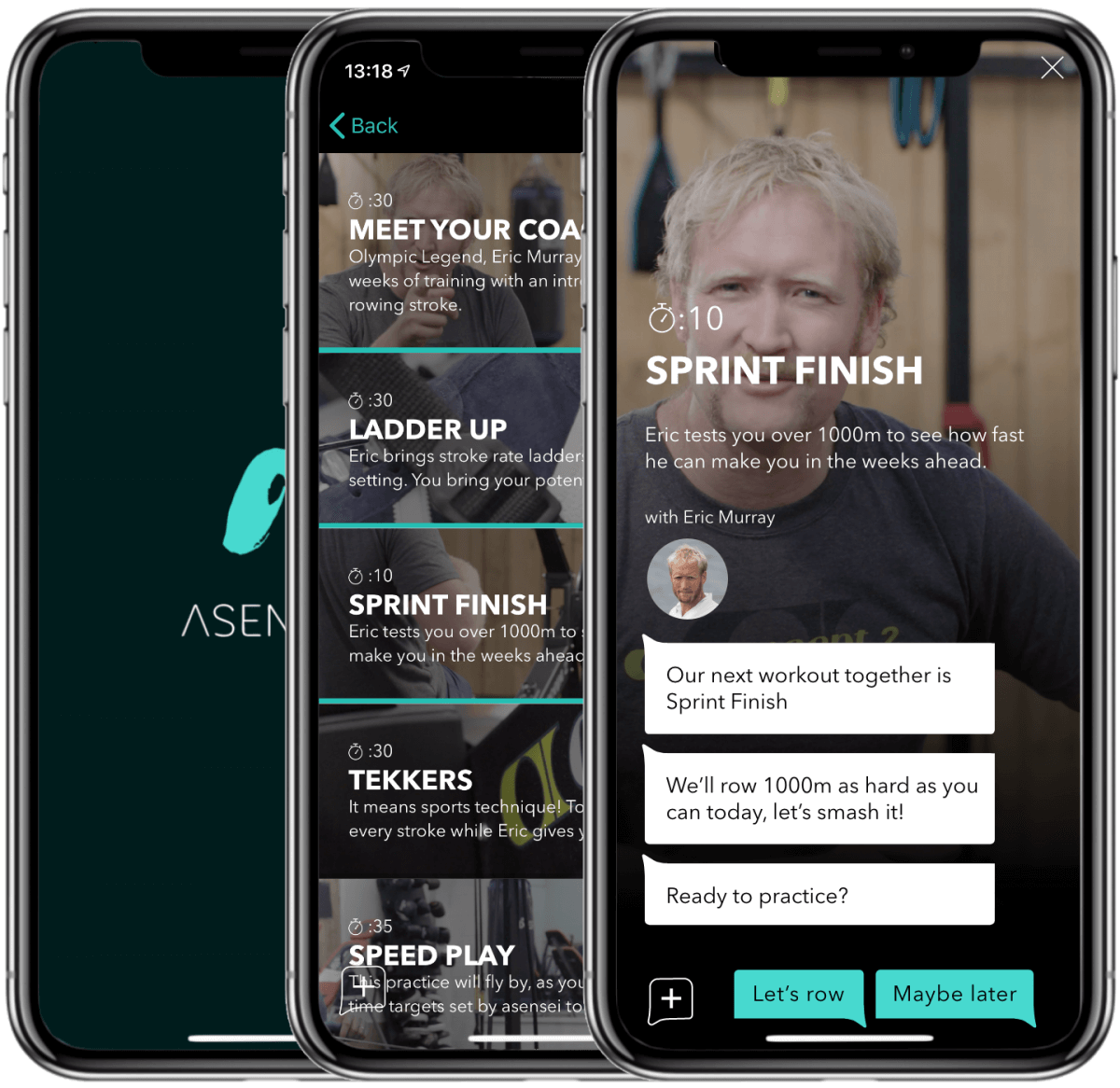
The asensei app guides you through structured programs with personalized workouts.
We should add that there is no right answer to the question above. Your personal requirements and aims mean that any one training program may not be exactly right for you, so it’s important you know what you’re hoping to achieve before setting out on this journey. In a recent study conducted by British Rowing, it was found that 22% of people who had started indoor rowing at home in the past six months felt that they did not know enough workouts compared to 9% of the total sample size. Feel free to check out the asensei app which includes a free trial, our YouTube channel which includes row along videos suitable for all rowing machines, and website for more details on how to get started. If you sign up for our newsletter, you’ll receive coaching tips and a free featured workout every week direct to your inbox.
Whatever training method you choose, videos, plans, coaches or a dedicated program will support your learning and allow you to make a positive start to what we hope will be a long and enjoyable indoor rowing experience!
Conclusion
Indoor rowing at home is a versatile, dynamic way to lose weight, strengthen muscle and build anaerobic threshold and the growing trend in households purchasing their own erg shows no sign of abating. Even in a post-COVID world, people are increasingly making the choice to work out from home due to its convenience, cost and flexibility. If you are ready to take that step then we hope this article will help you to achieve your perfect home rowing environment setup. As laid out above, there are numerous ways to engage and several choices at each phase of your decision-making process - which machine to select, where to put it, how to set it up, which training programs to follow. Whichever direction you decide to go in, rest assured that indoor rowing remains a fantastic choice for working out and that asensei can help you orientate that world in as much depth as you’re comfortable with. Reach out and tell us more about your setup at support@asensei.com or sign up and join the discussion in our members community on Facebook.
DOWNLOAD ASENSEI FOR FREE
Rowing training is better in the asensei app. Ideal for use at home, it guides you through structured training programs keeping you accountable. You will have all the key stats displayed on screen during your session, you will have asensei set you personalized goals, you won't need to program the machine or take note of your results, asensei does it all.
|
asensei is FREE to download and with no commitment you can trial the first 3 workouts in the (RE)COMMIT program and also workouts from MASTER THE BASICS, (RE)FOCUS, SWEAT FACTORY and BE A DARK HORSE. All you need is an iPhone and access to an asensei Compatible rowing machine from Concept 2, WaterRower or FluidRower with a bluetooth capable monitor. |





